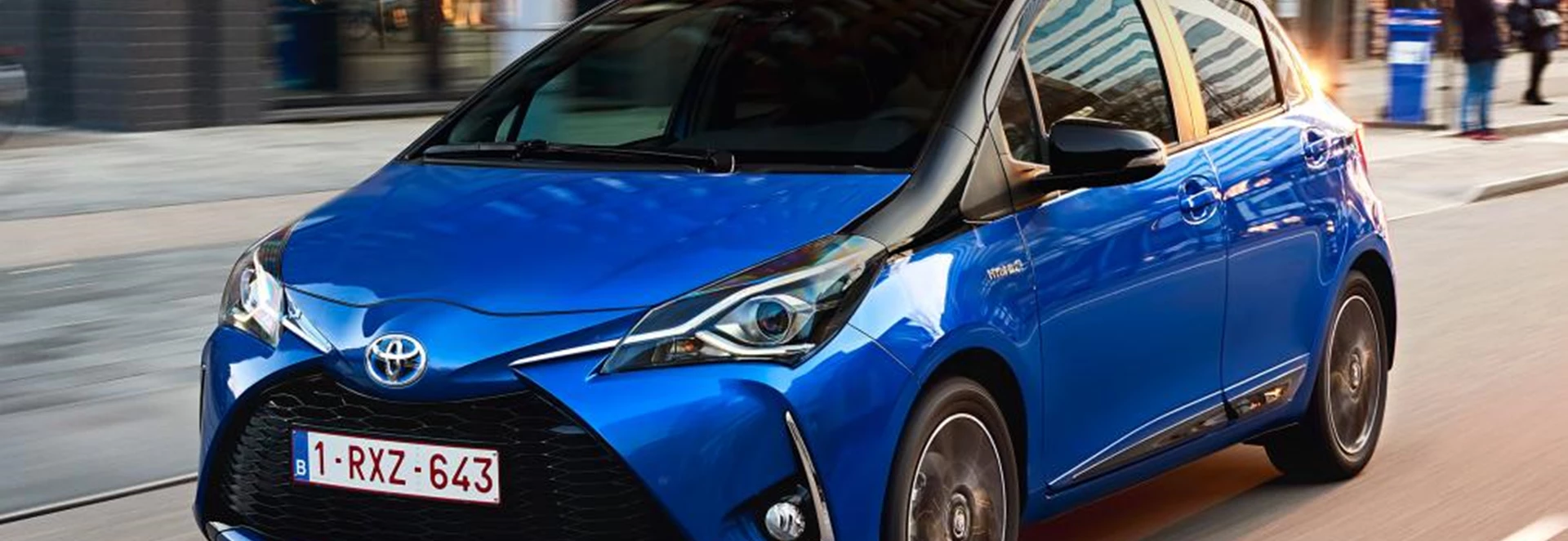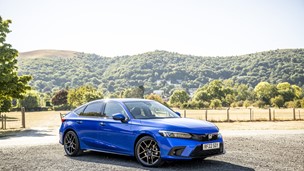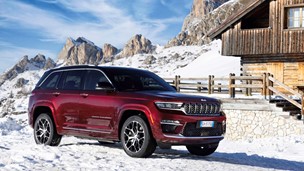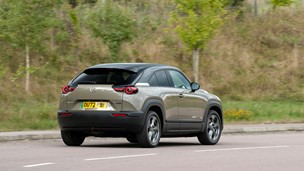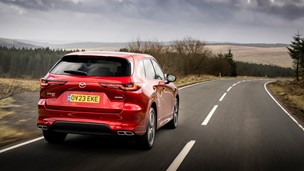Toyota’s pint-sized hybrid gets new looks, new kit and more
Introduction
In a world where hybrid and electric cars have rapidly gone from being extremely niche options to products that everyone’s talking about and every manufacturer is striving to bring to market, it’s strange that the Toyota Yaris Hybrid remains the only hybrid supermini in Britain.
That also happens to mean that it’s an important car for Toyota, and it’s also been the subject of heavy investment on the Japanese manufacturer’s behalf with this newly-facelifted 2017 model the result.
The headlines are as follows: new looks, with a fully new front end and a new headlight signature that gives the Yaris much more presence and personality. A whole new trim structure, plus a newly-integrated infotainment system in the interior, and the addition of lots more safety kit as standard.
Hybrid models specifically have received even more updates over the standard Yaris, with things like revised steering, changes to the suspension to improve ride quality and more sound deadening for better refinement.
Currently, around a third of all Yaris’ sold here in the UK are hybrids, and Toyota says that with the new updates it expects that to go up to around 40 per cent by the end of the year. So, what’s this nipped and tucked pint-sized hybrid like?
Performance
Toyota has left the powertrain untouched for the facelifted 2017 Yaris Hybrid, which means that it’s still powered by the combined efforts of a 1.5-litre petrol engine and an electric motor, both of which together produce a maximum power output of 98bhp.
What is new is a number of revisions designed to make the Hybrid even more refined, something which came directly from customer requests, apparently. Top of the list are new engine mounts to transmit fewer vibrations into the cabin, along with extra sound deadening to reduce noise by around 5.5db.
Hardly huge changes, and the CVT gearbox still has that characteristic groan when you open the throttle, but it does seem less noisy than previous versions and it’s certainly smooth to accelerate. The lack of any real power does mean that it’s quite slow, however, with 0-62mph taking a leisurely 11.8 seconds.
Not that that really matters, of course. Where the Yaris Hybrid excels, as it always has, is in urban driving where it’s happy to cruise along under near-silent electric power, and it does feel noticeably more refined than its purely petrol-powered siblings.
The car also tends to stay in pure electric mode for an impressive amount of time, only allowing the engine to cut in under heavier acceleration and then only to act as an assist to the electric motors, which both improves overall refinement and also reduces fuel consumption.
Ride and Handling
Toyota has worked hard to get the little Yaris to ride like a bigger car too and when you’re simply tooling around it does the job nicely.
Also new for the Yaris Hybrid is revisions to the steering and suspension to make it handle better, including stiffer springs to better deal with the extra weight the Hybrid model carries thanks to those battery packs housed under the floor.
While you’d probably have to drive it back-to-back with the previous Yaris Hybrid to notice any real discernible difference in steering feel, it does make for a relaxed and easy-going car to drive and glides over lumps and bumps with ease.
It’s very easy to manoeuvre and park as well, with light steering, a tight turning circle and compact dimensions which mean it’s effortless to place on the road and in parking spaces alike, handy for a car whose natural habitat is likely to be urban streets rather than rural moorland.
Toyota has worked hard to get the little Yaris to ride like a bigger car too and when you’re simply tooling around it does the job nicely, though naturally it lacks the poise of the Ford Fiesta or Volkswagen Polo when you push it a little harder.
Particularly, you can feel the added weight of the battery packs which manifests as a noticeable heft in tighter corners and it’s not exactly a spectacular car to drive with any real urgency, but again it’s not really meant to be and is a competent and easy to get along with motor for short distance urban runs.
Did you know?
The original Toyota Yaris was named Car of the Year back in 2000, for its funky looks, versatility and its innovative ‘Mighty Atom’ 1.0-litre engine.
Interior and Equipment
The other major change to the new Yaris line-up is an update for the interior, along with a completely new trim structure. Modernity is key, Toyota says, and so all Yaris’ with the exception of the entry-level Active models get a newly-integrated 6.2-inch infotainment console, while all cars in the range get more kit as standard and a slightly tweaked interior.
While the Yaris still doesn’t feel quite as classy on the inside as the Polo or Mazda 2, or as chic as an Ibiza or 208, this facelifted model is certainly the best yet for interior quality with plenty of materials which are solidly built but soft to the touch.
The interior layout is much nicer to look at this time round, and while there are some niggles like the fact that the steering wheel doesn’t have all that much adjustability, there’s plenty of room for driver and passenger in the front.
Standard equipment across the range includes automatic wipers, Bluetooth and a six-speaker audio system, while the Hybrid benefits from automatic air conditioning and projector headlamps over the standard Yaris.
Stepping up to the range-topping Excel trim we tested adds premium features like automatic lights, larger alloy wheels and chrome touches on the exterior. The infotainment system, which is standard on all except the basic models, is a bit of a disappointment, however. Its slow responsiveness, sometimes clumsy interface and the fact that it lacks the latest must-have phone integration features like Apple CarPlay or Android Auto means it trails behind many rival systems.
Still, all Yaris models do now benefit from the Toyota Safety Sense package, which adds a range of safety kit including lane departure warning, semi-autonomous emergency braking and automatic high beam lights.
Rear passenger space is decent, if not exactly class leading, though access is improved by the fact that the Yaris is available exclusively as a five-door in the UK. Its 286-litre boot isn’t the best in class either, but is more than acceptable for a supermini and unlike other hybrid cars the placement of the Yaris’ battery packs doesn’t eat into luggage capacity.
Cost
With the new tax regulations introduced this year, most low-emissions cars will no longer enjoy the same tax breaks that they used to.
One potential problem is that with the new tax regulations introduced on 1st April 2017, most low-emissions cars will no longer enjoy the same tax breaks that they used to. Under the previous rules, any car emitting less than 99g/km of CO2 got free road tax, but now you’ll need a fully electric, completely zero-emissions car to avoid paying tax.
The slight silver lining is that hybrids, along with other alternatively-fuelled cars like hydrogen fuel cell vehicles, do pay slightly less than other cars - £130 per year, compared to £140 for petrol or diesel vehicles. BIK rates of 13 per cent will also make it attractive to fleet customers.
But with that in mind, will the Yaris Hybrid still make as much sense for private buyers? It still benefits from fuel economy figures of up to 85.6mpg, a good 20mpg or so more than the second most efficient Yaris option and you’ll skip Congestion Charge too, but does that warrant the £3,500 premium over the standard car?
Yep, that’s how much extra you’ll pay for the Hybrid. The entry-level Yaris in Active trim with the 1.0-litre engine starts from £12,495, while you’ll have to stump up £15,995 for the most basic Yaris Hybrid. The range-topping Excel trim we tested the car in starts from £19,295 in Hybrid guise.
Still, if you’re committed to the Hybrid the good news is that it gets the same five-year/100,000-mile warranty as every other Yaris, while Toyota also says that servicing costs are cheaper for this model than they are for a petrol-powered Yaris. Whether that makes sense is ultimately up to you and your personal preferences.
Our Verdict
From its new raft of safety kit to its attractive running costs and Toyota’s unshakeable reliability record, the new Toyota Yaris certainly has a lot going for it, and we’re sure it’ll appeal to private and business buyers alike.
To date, it’s still unique within its segment and that’s a powerful plus for it as well; a true, compact hybrid where most other manufacturers are busy figuring out how to fit hybrid gear into large saloons in SUVs.
However, the fact can’t be ignored that there are cars out there that might offer slightly lower fuel consumption figures, but which are better to drive, more practical, more attractive inside and less expensive. Also, the shakeup in tax rules could potentially hobble the Hybrid’s appeal compared to a regular petrol model.
